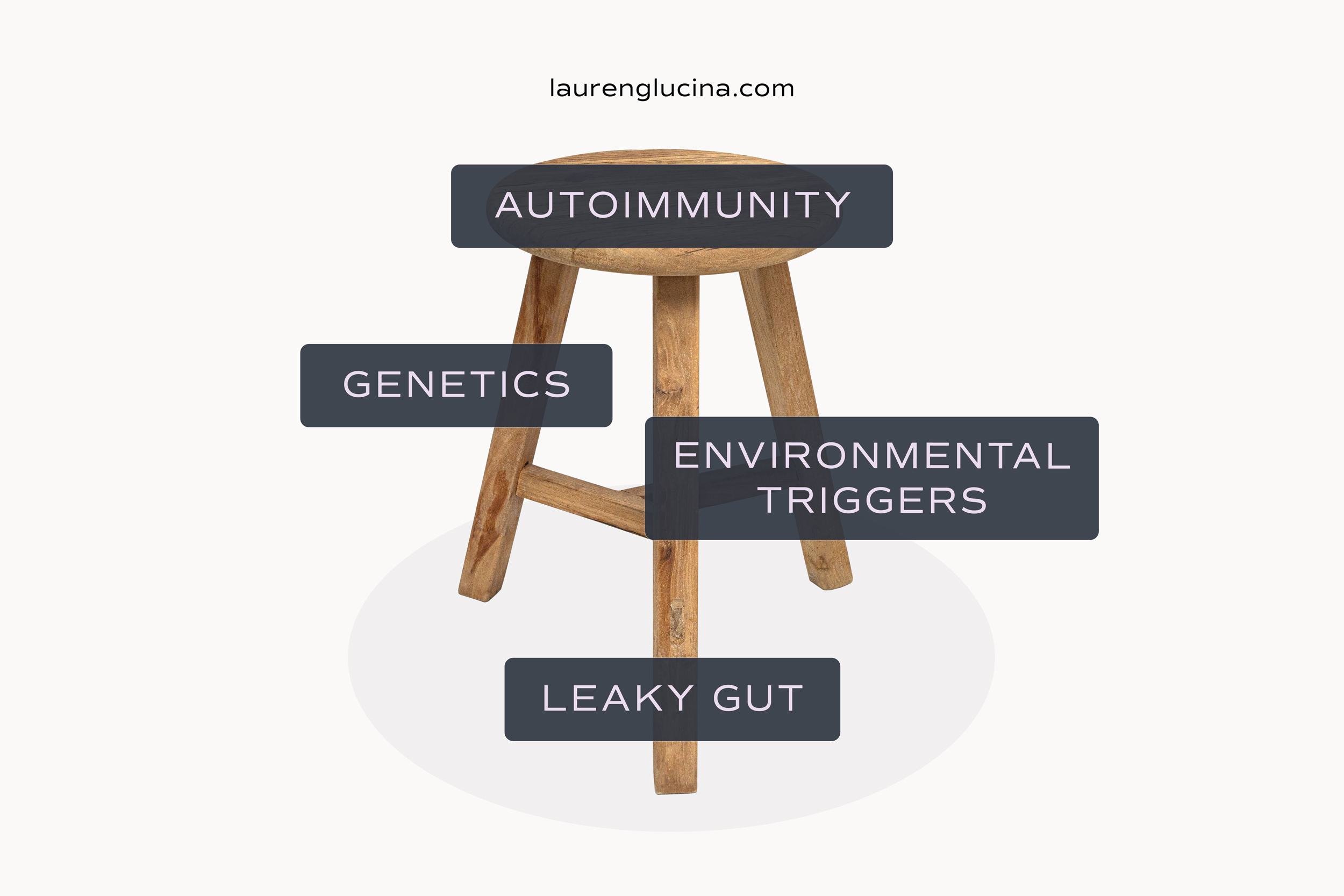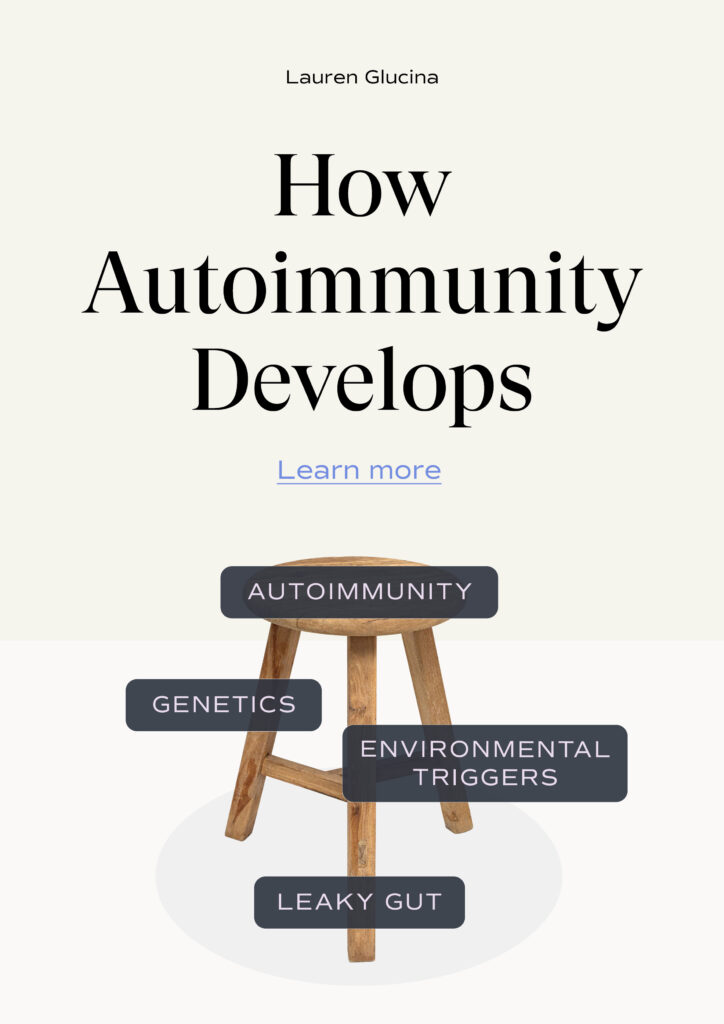Learn about the three-legged stool of autoimmunity, a powerful analogy that explains the interplay of genetics, environmental factors, and leaky gut in the development of autoimmune diseases.

Autoimmune thyroid disease is a common autoimmune condition in New Zealand, particularly among women, with circulating antibodies detected in about 15% of the population [Source].
Autoimmunity occurs when the immune system fails to differentiate between self and non-self, leading to the production of antibodies that attack the body’s own cells, tissues, and organs, causing inflammation and damage.
For many dealing with autoimmunity, a crucial question is: “How did I get here?” To explain this, let’s use the analogy of a three-legged stool.
🪑 The three-legged stool of autoimmunity
This concept is inspired by the work of gastroenterologist and researcher Dr. Alessio Fasano. He identifies three key factors necessary for autoimmunity to develop:
- Genetic susceptibility
- Environmental triggers
- Leaky gut
All three “legs” need to be present for autoimmunity to manifest.
Though addressing all legs of the stool must be part of the ultimate solution, the healing of even one or two legs will make a significant difference in the management of autoimmunity, potentially putting it into remission and preventing its onset.
After all – a three-legged stool can’t stand with a missing leg or two!
🧬 Genetic susceptibility
Genetic susceptibility is the first of the three legs. For example, certain HLA-DQA1 and HLA-DQB1 gene variants are associated with an increased risk of developing celiac disease.
However, our genes do not determine our fate. Even if you have a predisposition for a certain disease, it doesn’t guarantee that it will manifest.
In some cases, nutrigenomics can be used to make personalised dietary choices that improve health, help prevent disease, and optimise overall well-being by tailoring nutrition to an individual’s genetic profile.
🧬 Nutrigenomics is the study of how your genes interact with the foods you eat. It looks at how your genetic makeup affects the way your body responds to nutrients, vitamins, and other components in your diet. 🥦
🦠 Environmental triggers
Environmental triggers are varied and can be the “tipping point” for the onset of autoimmunity. Many individuals report they “have never been well since” exposure to mould, severe infections, viral illnesses like Epstein-Barr or traumatic life events such as divorce… to give a few examples.
Sometimes, it is a combination of stressors that overwhelms the body, triggering autoimmunity.
This is why it is helpful to reflect on what was going on for you at the onset of your symptoms… do a bit of detective work! Look for those triggers, then work to address them as thoroughly as possible, one by one – this is crucial for healing!
Common triggers include:
- Infections (viral, bacterial, parasitic such as Epstein-Barr virus, herpes simplex, H. pylori)
- Mycotoxins (toxins from mould)
- Heavy metals (e.g., mercury in amalgam fillings, lead in cigarettes)
- Environmental chemicals (herbicides, pesticides)
- Emotional trauma (e.g., divorce, loss of a loved one, loss of income, loss of independence)
- Physical trauma (severe illness, accidents)
👩🔬 Leaky gut
The third leg, often referred to as “leaky gut” or intestinal permeability, can result from factors such as antibiotics, NSAIDs, diets high in processed foods, gluten, chronic stress, alcohol, and chemical exposure (e.g., glyphosate).
These factors can inflame and damage the gut lining, causing the tight junctions between epithelial cells to become compromised. This allows larger molecules like undigested food particles and toxins to enter the bloodstream, potentially triggering autoimmunity in susceptible individuals [Source].
How does this happen? It all comes down to a case of mistaken identity.
Unfortunately, there are certain proteins that are dead ringers for your body’s own tissue.
When these proteins/food antigens enter the bloodstream, they are ‘tagged’ by the immune system as foreign invaders, but the antibodies created in response mistakenly attack both self, and non-self, simply because they can’t distinguish between the two.
For instance, proteins like gliadin from wheat and casein from dairy look a heck of a lot like thyroid tissue, leading the immune system to inadvertently target and attack the thyroid gland.
Leaky gut can be tested and treated using the 4-R approach:
- REMOVE inflammatory triggers, including dietary triggers like gluten and dairy, and microbial overgrowth such as SIBO
- RESTORE digestive secretions using supplements like hydrochloric acid and digestive enzymes
- REINOCULATE the gut with healthy bacteria using probiotics, prebiotics, and fermented foods
- REPAIR the gut lining with nutrients such as L-glutamine and zinc-l-carnosine
❤️🩹 Final thoughts
Whether it’s Hashimoto’s, Graves’, or any other autoimmune condition, just know that it is possible to knock the legs out from underneath it and get yourself into a better place.
By thoroughly identifying and addressing all potential triggers, and making a concerted effort to heal the gut, a healthier version of yourself is within reach 😊
Hope you found that helpful, if you’d like to work with me 1:1, book a consult here.
With love,
Lauren.






Comments +